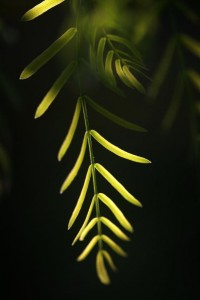How Juniper and Mesquite Trees Could Help Fuel Texas

Photo by David McNew/Getty Images
The leaves of a honey mesquite tree. Excess trees could be harvested and used as biofuels.
Scientists may have found something more than just rings in the heart of Texas’ Juniper and Mesquite trees – more than 8,000 Btu in renewable bioenergy per pound, according to experts at Texas Agrilife Research. That’s roughly equivalent to “medium grade subbituminous coal,” according to Agrilife.
The Juniper and Mesquite trees now covering more than sixty million acres of brushland could be converted to biofuel by a process called biomass gassification. Biomass gassification produces syngas – a natural gas substitute consisting of carbon monoxide, ethane and hydrogen. Tar is also formed from biomass gassification and may be used as a fuel source.
Texas AgriLife Research rangeland ecologist, Dr. Jim Ansley, considers the Juniper and Mesquite trees to be a relatively untapped energy resource.
“Right now, they are perceived as noxious plants that are detrimental to rangeland ecosystems,” said Ansley, “Their removal and use as a bioenergy feedstock would improve ecosystem quality as well as services from these lands, such as increased income from livestock grazing.” Ansley and his colleagues conducted a study to determine the basic properties of Juniper and Mesquite wood chips when used as fuel.
Mesquite and Juniper woods proved to be better quality fuel than cattle manure biomass. You can visit our topic page on the Non-Wind and Non-Solar Renewable Resources of Texas to learn more about Texas biofuels.
